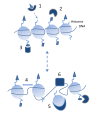Chromatin proteins: key responders to stress
- PMID: 22859908
- PMCID: PMC3409139
- DOI: 10.1371/journal.pbio.1001371
Chromatin proteins: key responders to stress
Abstract
Environments can be ever-changing and stresses are commonplace. In order for organisms to survive, they need to be able to respond to change and adapt to new conditions. Fortunately, many organisms have systems in place that enable dynamic adaptation to immediate stresses and changes within the environment. Much of this cellular response is coordinated by modulating the structure and accessibility of the genome. In eukaryotic cells, the genome is packaged and rolled up by histone proteins to create a series of DNA/histone core structures known as nucleosomes; these are further condensed into chromatin. The degree and nature of the condensation can in turn determine which genes are transcribed. Histones can be modified chemically by a large number of proteins that are thereby responsible for dynamic changes in gene expression. In this Primer we discuss findings from a study published in this issue of PLoS Biology by Weiner et al. that highlight how chromatin structure and chromatin binding proteins alter transcription in response to environmental changes and stresses. Their study reveals the importance of chromatin in mediating the speed and amplitude of stress responses in cells and suggests that chromatin is a critically important component of the cellular response to stress.
Conflict of interest statement
The authors have declared that no competing interests exist.
Figures


Comment on
-
Systematic dissection of roles for chromatin regulators in a yeast stress response.PLoS Biol. 2012;10(7):e1001369. doi: 10.1371/journal.pbio.1001369. Epub 2012 Jul 31. PLoS Biol. 2012. PMID: 22912562 Free PMC article.
References
Publication types
MeSH terms
Substances
Grants and funding
LinkOut - more resources
Full Text Sources
Molecular Biology Databases

